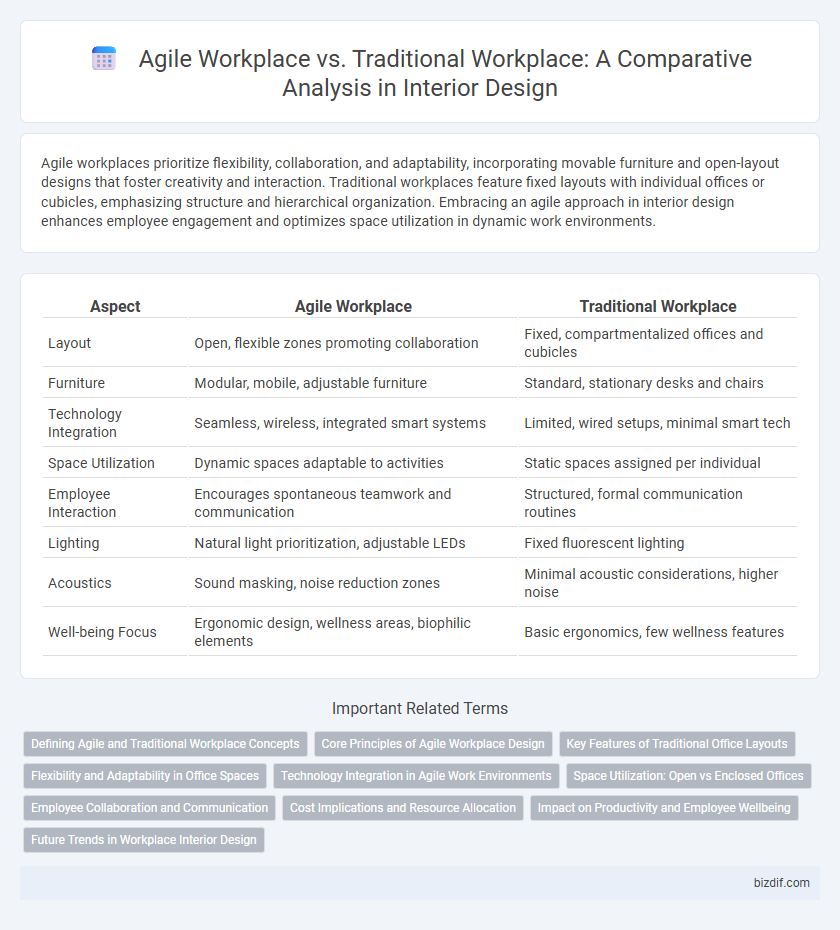Agile workplaces prioritize flexibility, collaboration, and adaptability, incorporating movable furniture and open-layout designs that foster creativity and interaction. Traditional workplaces feature fixed layouts with individual offices or cubicles, emphasizing structure and hierarchical organization. Embracing an agile approach in interior design enhances employee engagement and optimizes space utilization in dynamic work environments.
Table of Comparison
| Aspect | Agile Workplace | Traditional Workplace |
|---|---|---|
| Layout | Open, flexible zones promoting collaboration | Fixed, compartmentalized offices and cubicles |
| Furniture | Modular, mobile, adjustable furniture | Standard, stationary desks and chairs |
| Technology Integration | Seamless, wireless, integrated smart systems | Limited, wired setups, minimal smart tech |
| Space Utilization | Dynamic spaces adaptable to activities | Static spaces assigned per individual |
| Employee Interaction | Encourages spontaneous teamwork and communication | Structured, formal communication routines |
| Lighting | Natural light prioritization, adjustable LEDs | Fixed fluorescent lighting |
| Acoustics | Sound masking, noise reduction zones | Minimal acoustic considerations, higher noise |
| Well-being Focus | Ergonomic design, wellness areas, biophilic elements | Basic ergonomics, few wellness features |
Defining Agile and Traditional Workplace Concepts
Agile workplaces emphasize flexible layouts, collaborative zones, and adaptable furniture designed to support dynamic team interactions and evolving project needs. Traditional workplaces feature fixed desks, hierarchical office arrangements, and designated private offices that prioritize individual work and structured workflows. Understanding these core concepts guides interior design strategies to foster innovation or maintain conventional operational efficiency.
Core Principles of Agile Workplace Design
Agile workplace design emphasizes flexibility, adaptability, and collaboration by integrating modular furniture, open layouts, and technology-enabled spaces that support diverse work styles and dynamic team configurations. Unlike traditional workplaces that rely on fixed desks and hierarchical zoning, agile environments prioritize employee autonomy, fluid movement, and real-time communication to enhance productivity and innovation. Core principles include scalability, user-centricity, and seamless integration of digital and physical elements to foster a culture of agility and engagement.
Key Features of Traditional Office Layouts
Traditional office layouts typically feature fixed workstations arranged in rows or clusters, emphasizing hierarchical organization and clear separation of roles. Enclosed private offices and cubicles provide individual privacy but limit flexibility and collaboration. These layouts prioritize structure and control, often resulting in static spaces with limited adaptability to changing work styles.
Flexibility and Adaptability in Office Spaces
Agile workplaces prioritize flexibility by featuring modular furniture and open layouts that easily reconfigure to support diverse work styles and team collaborations. Traditional workplaces often rely on fixed, compartmentalized spaces that limit adaptability to changing organizational needs. Incorporating adaptable elements like movable partitions and multipurpose zones enhances productivity and employee satisfaction in modern office environments.
Technology Integration in Agile Work Environments
Agile workplaces prioritize advanced technology integration, utilizing IoT devices, cloud computing, and collaborative software to enhance flexibility and real-time communication. Unlike traditional workplaces that rely on fixed infrastructure and legacy systems, agile environments support seamless remote access and dynamic space reconfiguration powered by smart sensors and automation technology. This technological foundation improves productivity, employee engagement, and adaptive space management in rapidly changing work scenarios.
Space Utilization: Open vs Enclosed Offices
Agile workplaces optimize space utilization by incorporating open office layouts that promote flexibility, collaboration, and dynamic use of areas. Traditional workplaces often rely on enclosed offices and cubicles, which limit adaptability and fragment communication. Open office designs in agile environments enhance natural light distribution and encourage multifunctional zones, maximizing overall spatial efficiency.
Employee Collaboration and Communication
Agile workplace design promotes dynamic spaces that foster spontaneous employee collaboration and enhance real-time communication through flexible layouts and multifunctional furniture. Traditional workplaces often rely on fixed desks and enclosed offices, which can limit interaction and slow down information flow among team members. By integrating open-plan areas and technology-enabled hubs, agile environments support greater teamwork efficiency and seamless knowledge sharing.
Cost Implications and Resource Allocation
Agile workplaces significantly reduce overhead costs by optimizing flexible use of shared spaces and minimizing dedicated workstations, resulting in lower real estate expenses compared to traditional workplaces with fixed desks and private offices. Resource allocation in agile environments prioritizes modular furniture and technology investments that enhance collaboration and adaptability, whereas traditional settings often invest heavily in static infrastructure and individualized equipment. This shift promotes operational efficiency and cost savings by aligning physical resources more closely with dynamic team needs and occupancy patterns.
Impact on Productivity and Employee Wellbeing
Agile workplaces foster enhanced productivity through flexible layouts that promote collaboration and adaptability, contrasting with traditional workplaces' static, hierarchical designs that may inhibit employee engagement. Incorporating dynamic furniture, open spaces, and technology integration in agile environments supports wellbeing by reducing stress and encouraging movement, while traditional setups often contribute to physical discomfort and mental fatigue. Research indicates that employees in agile settings report higher satisfaction and efficiency, emphasizing the importance of design innovation in boosting workforce performance.
Future Trends in Workplace Interior Design
Future trends in workplace interior design emphasize agile workplaces that prioritize flexibility, collaboration, and employee well-being over rigid layouts found in traditional workplaces. Incorporating adaptable furniture, multipurpose spaces, and technology integration supports dynamic workstyles and enhances productivity. Sustainable materials and biophilic design elements increasingly influence interiors, reflecting a shift toward environmentally conscious, human-centered work environments.
Agile Workplace vs Traditional Workplace Infographic

 bizdif.com
bizdif.com